AI Terms
What is Edge AI? When Intelligence Lives Where You Need It

Your security camera shouldn't need the cloud to recognize an intruder. Your factory robot shouldn't wait for server responses to avoid collisions. Edge AI puts intelligence directly where decisions happen, delivering instant responses without internet delays or privacy concerns.
Technical Definition
Edge AI refers to artificial intelligence algorithms processed locally on hardware devices at the "edge" of the network, rather than in centralized cloud servers. This includes running AI models on smartphones, IoT devices, autonomous vehicles, industrial equipment, or dedicated edge servers.
According to Gartner, "Edge AI will be embedded in more than 50% of new industrial IoT solutions by 2025." The technology combines optimized AI models with specialized hardware like neural processing units (NPUs) to enable real-time inference without network connectivity.
Edge AI emerged from the convergence of more powerful edge devices, model compression techniques, and the need for low-latency, privacy-preserving AI applications.
Business Perspective
For business leaders, Edge AI means instant intelligence wherever you operate – from retail stores to remote oil rigs – without depending on internet connectivity, cloud costs, or risking data privacy.
Think of Edge AI as having expert consultants embedded in every device, vehicle, and sensor across your operations. They make smart decisions instantly based on local conditions, only escalating to headquarters when necessary.
In practical terms, this enables real-time quality control on production lines, instant fraud detection at ATMs, personalized retail experiences in-store, and autonomous operations in remote locations.
Core Capabilities
Edge AI delivers these advantages:
• Ultra-Low Latency: Decisions in milliseconds, not seconds, critical for safety systems, autonomous vehicles, and real-time control
• Privacy Protection: Sensitive data never leaves the device, ensuring compliance with regulations and customer trust
• Offline Operation: Full AI capabilities without internet connectivity, enabling deployment in remote or secure locations
• Bandwidth Efficiency: Process data locally instead of streaming to cloud, reducing network costs by 90%+
• Scalable Intelligence: Deploy AI across thousands of devices without proportional cloud infrastructure costs
How Edge AI Works
The Edge AI architecture follows this pattern:
Model Optimization: Full AI models compressed and optimized for edge hardware using techniques like quantization and pruning
Local Processing: Specialized chips (NPUs, TPUs) run AI inference directly on device, processing sensor data in real-time
Smart Orchestration: Edge devices handle routine decisions locally while selectively sending complex cases or aggregated insights to cloud
This creates a distributed intelligence network that combines edge speed with cloud sophistication when needed.
Edge AI Deployment Models
Different architectures for different needs:
Model 1: On-Device AI Location: Smartphone, camera, sensor Best for: Personal devices, privacy-critical Example: Face ID on iPhone, Google Translate offline
Model 2: Gateway Edge Location: Local server or gateway device Best for: Multiple IoT devices, facility management Example: Smart building systems, retail analytics
Model 3: Network Edge Location: Telecom infrastructure, 5G towers Best for: Low-latency services, AR/VR Example: Cloud gaming, autonomous vehicles
Model 4: Hybrid Edge-Cloud Location: Coordinated edge and cloud Best for: Complex systems, learning loops Example: Industrial IoT with continuous improvement
Real-World Edge AI
Companies deploying intelligence at the edge:
Manufacturing Example: BMW's factories use Edge AI for real-time quality inspection, detecting paint defects in milliseconds on the production line. This prevents defective products from progressing, saving $1.2M annually per plant.
Retail Example: Amazon Go stores process hundreds of AI decisions per second locally to track what customers take, enabling checkout-free shopping while ensuring privacy by not sending video to cloud.
Healthcare Example: Philips' portable ultrasound devices use Edge AI to guide non-experts through scans, providing instant analysis in remote clinics without internet connectivity, expanding care to underserved areas.
When to Deploy Edge AI
Edge AI excels in scenarios requiring:
• Instant Response: Autonomous vehicles, safety systems, industrial control where milliseconds matter • Privacy Requirements: Healthcare, financial services, government where data cannot leave premises • Intermittent Connectivity: Ships, mines, rural deployments with unreliable internet • High-Volume Processing: Video analytics, sensor networks where cloud bandwidth would be prohibitive • Distributed Operations: Retail chains, logistics networks needing consistent local intelligence
Implementation Considerations
Key factors for Edge AI success:
Hardware Selection:
- Processing power vs. energy consumption
- Environmental conditions (temperature, vibration)
- Form factor constraints
- Cost at scale
Model Optimization:
- Accuracy vs. size tradeoffs
- Quantization and pruning strategies
- Update mechanisms
- Fallback options
System Architecture:
- Edge-cloud coordination
- Data synchronization
- Security at the edge
- Management at scale
Getting Started with Edge AI
Ready to distribute intelligence across your operations?
- Understand AI Model Optimization
- Explore IoT and AI Integration
- Learn about Edge Computing
- Read our Edge AI Deployment Guide
Part of the [AI Terms Collection]. Last updated: 2025-01-11